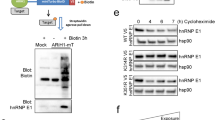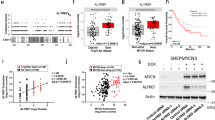Abstract
The Nf2 tumor suppressor codes for merlin, a protein whose function is largely unknown. We have previously demonstrated a novel interaction between merlin and TRBP, which inhibits the oncogenic activity of TRBP. In spite of the significance of their functional interaction, its molecular mechanism still remains to be elucidated. In this report, we investigated how merlin inhibits the oncogenic activity of TRBP in association with cell growth conditions. In the human embryonic kidney 293 cell line, the level of endogenous merlin increased, whereas that of endogenous TRBP significantly decreased along with the increase in cell confluence. We demonstrated that the carboxyl-terminal region of TRBP was responsible for this phenomenon using stable cell lines expressing deletion mutants of TRBP. The overexpression of merlin decreased the protein level of TRBP, and the ubiquitin-like subdomain of merlin's FERM domain was important for this activity. We also demonstrated that TRBP is ubiquitinylated and the ubiquitinylated forms of TRBP are accumulated by ectopically expressed merlin or cell confluence in the presence of MG132, a proteasome inhibitor. Furthermore, we showed that the regulation of TRBP in response to cell confluence was abolished upon knockdown of merlin expression by specific small interfering RNA. Finally, we showed that ectopically expressed merlin restored cell–cell contact inhibition in cells stably expressing TRBP but not in TRBPΔc. These results suggest that merlin is involved in the regulation of TRBP protein level by facilitating its ubiquitination in response to such cues as cell–cell contacts.
This is a preview of subscription content, access via your institution
Access options
Subscribe to this journal
Receive 50 print issues and online access
$259.00 per year
only $5.18 per issue
Buy this article
- Purchase on Springer Link
- Instant access to full article PDF
Prices may be subject to local taxes which are calculated during checkout








Similar content being viewed by others
Abbreviations
- NF2:
-
neurofibromatosis type 2
- TRBP:
-
trans-activation-responsive RNA-binding protein
- dsRBD:
-
double-stranded RNA-binding domain
References
Bannwarth S, Talakoub L, Letourneur F, Duarte M, Purcell DF, Hiscott J et al. (2001). J Biol Chem 276(52): 48803–48813.
Bass BL, Hurst SR, Singer JD . (1994). Curr Biol 4(4): 301–314.
Benkirane M, Neuveut C, Chun RF, Smith SM, Samuel CE, Gatignol A et al. (1997). EMBO J 16(3): 611–624.
Bretscher A, Chambers D, Nguyen R, Reczek D . (2000). Annu Rev Cell Dev Biol 16: 113–143.
Bretscher A, Edwards K, Fehon RG . (2002). Nat Rev Mol Cell Biol 3(8): 586–599.
Daher A, Longuet M, Dorin D, Bois F, Segeral E, Bannwarth S et al. (2001). J Biol Chem 276(36): 33899–33905.
Evans DG, Huson SM, Donnai D, Neary W, Blair V, Newton V et al. (1992a). J Med Genet 29(12): 847–852.
Evans DG, Huson SM, Donnai D, Neary W, Blair V, Teare D et al. (1992b). J Med Genet 29(12): 841–846.
Fisher HW, Yeh J . (1967). Science 155(762): 581–582.
Gatignol A, Buckler C, Jeang KT . (1993). Mol Cell Biol 13(4): 2193–2202.
Gautreau A, Manent J, Fievet B, Louvard D, Giovannini M, Arpin M . (2002). J Biol Chem 277(35): 31279–31282.
Giovannini M, Robanus-Maandag E, van der Valk M, Niwa-Kawakita M, Abramowski V, Goutebroze L et al. (2000). Genes Dev 14(13): 1617–1630.
Gusella JF, Ramesh V, MacCollin M, Jacoby LB . (1996). Curr Opin Genet Dev 6(1): 87–92.
Gusella JF, Ramesh V, MacCollin M, Jacoby LB . (1999). Biochim Biophys Acta 1423(2): M29–36.
Gutmann DH, Sherman L, Seftor L, Haipek C, Hoang Lu K, Hendrix M . (1999). Hum Mol Genet 8(2): 267–275.
Kharrat A, Macias MJ, Gibson TJ, Nilges M, Pastore A . (1995). EMBO J 14(14): 3572–3584.
Kim H, Kwak NJ, Lee JY, Choi BH, Lim Y, Ko YJ et al. (2004). J Biol Chem 279(9): 7812–7818.
Kissil JL, Johnson KC, Eckman MS, Jacks T . (2002). J Biol Chem 277(12): 10394–10399.
Kissil JL, Wilker EW, Johnson KC, Eckman MS, Yaffe MB, Jacks T . (2003). Mol Cell 12(4): 841–849.
Lee JY, Kim H, Ryu CH, Kim JY, Choi BH, Lim Y et al. (2004). J Biol Chem 279(29): 30265–30273.
Lee K, Fajardo MA, Braun RE . (1996). Mol Cell Biol 16(6): 3023–3034.
Park H, Davies MV, Langland JO, Chang HW, Nam YS, Tartaglia J et al. (1994). Proc Natl Acad Sci USA 91(11): 4713–4717.
Pearson MA, Reczek D, Bretscher A, Karplus PA . (2000). Cell 101(3): 259–270.
Rong R, Surace EI, Haipek CA, Gutmann DH, Ye K . (2004). Oncogene 23: 8447–8454.
Shaw RJ, Henry M, Solomon F, Jacks T . (1998a). Mol Biol Cell 9(2): 403–419.
Shaw RJ, McClatchey AI, Jacks T . (1998b). J Biol Chem 273(13): 7757–7764.
Shaw RJ, Paez JG, Curto M, Yaktine A, Pruitt WM, Saotome I et al. (2001). Dev Cell 1(1): 63–72.
Sherman L, Xu HM, Geist RT, Saporito-Irwin S, Howells N, Ponta H et al. (1997). Oncogene 15(20): 2505–2509.
St Johnston D, Brown NH, Gall JG, Jantsch M . (1992). Proc Natl Acad Sci USA 89(22): 10979–10983.
Sun CX, Robb VA, Gutmann DH . (2002). J Cell Sci 115(Part 21): 3991–4000.
Surace EI, Haipek CA, Gutmann DH . (2004). Oncogene 23(2): 580–587.
Tsukita S, Yonemura S . (1997). Curr Opin Cell Biol 9(1): 70–75.
Vijay-Kumar S, Bugg CE, Cook WJ . (1987). J Mol Biol 194(3): 531–544.
Xiao GH, Beeser A, Chernoff J, Testa JR . (2002). J Biol Chem 277(2): 883–886.
Zhong J, Peters AH, Lee K, Braun RE . (1999). Nat Genet 22(2): 171–174.
Acknowledgements
We thank Dr BH Choi for the invaluable advice and Dr CY Choi for the helpful comments and all the other members of our laboratory for their valuable assistance. This study was supported by a grant of the Korean Health 21 R&D Project, Ministry of Health Welfare, Republic of Korea (00-PJ3-PG6-GN02-0002, 01-PJ3-PG6-GN07-0004).
Author information
Authors and Affiliations
Corresponding author
Rights and permissions
About this article
Cite this article
Lee, J., Moon, H., Lee, W. et al. Merlin facilitates ubiquitination and degradation of transactivation-responsive RNA-binding protein. Oncogene 25, 1143–1152 (2006). https://doi.org/10.1038/sj.onc.1209150
Received:
Revised:
Accepted:
Published:
Issue Date:
DOI: https://doi.org/10.1038/sj.onc.1209150
Keywords
This article is cited by
-
SUMOylation of TARBP2 regulates miRNA/siRNA efficiency
Nature Communications (2015)
-
Regulation of mixed lineage kinase 3 is required for Neurofibromatosis-2-mediated growth suppression in human cancer
Oncogene (2011)
-
VprBP targets Merlin to the Roc1-Cul4A-DDB1 E3 ligase complex for degradation
Oncogene (2008)
-
Akt phosphorylation regulates the tumour-suppressor merlin through ubiquitination and degradation
Nature Cell Biology (2007)
-
Merlin
AfCS-Nature Molecule Pages (2006)



